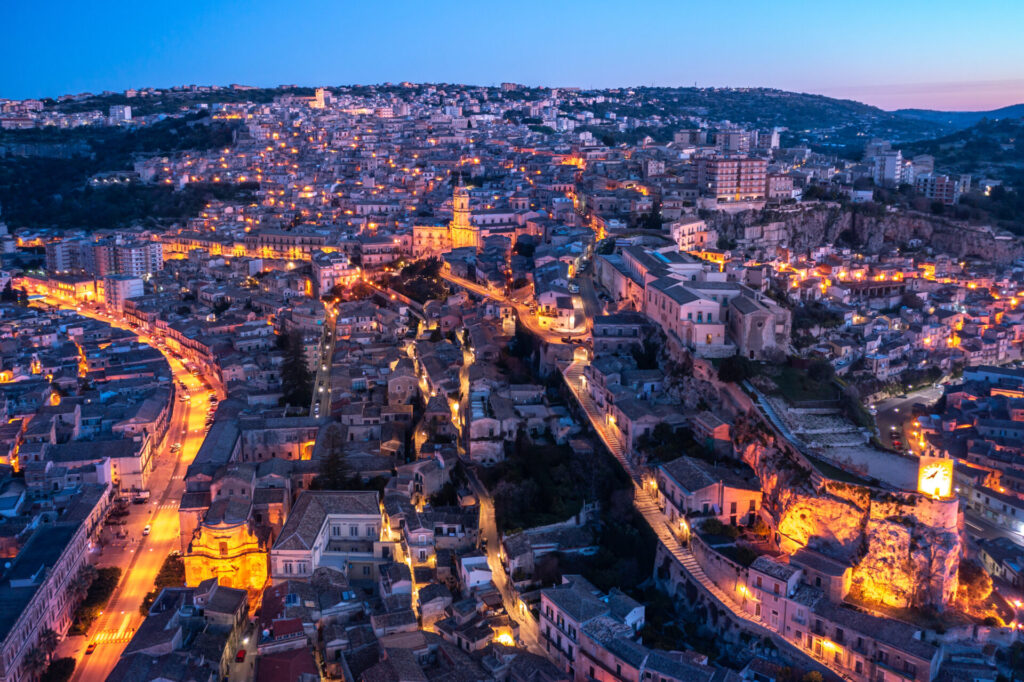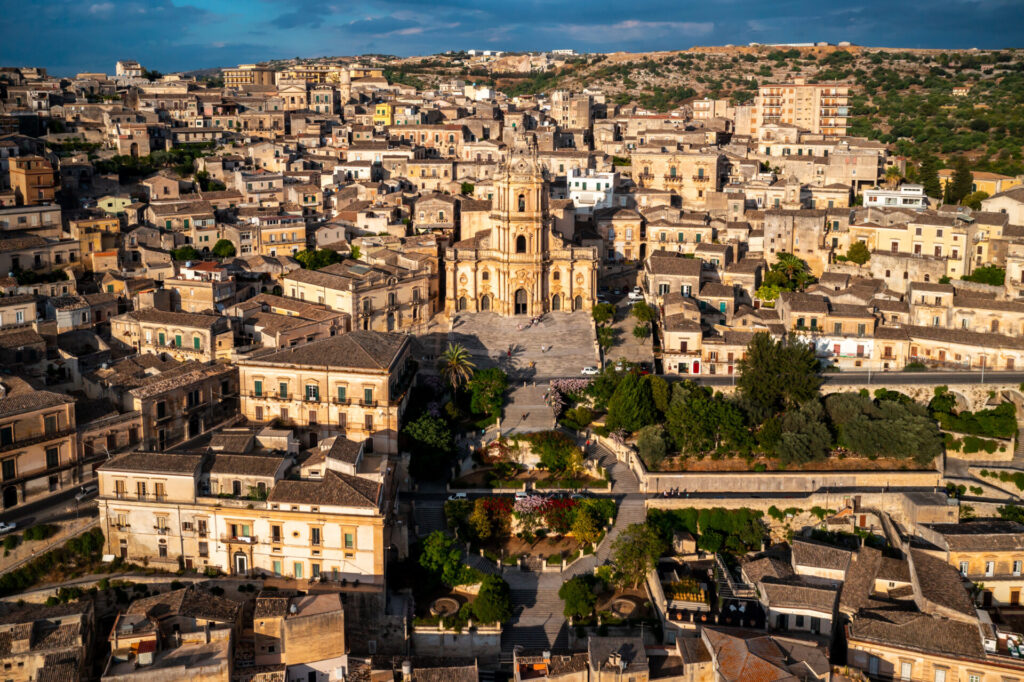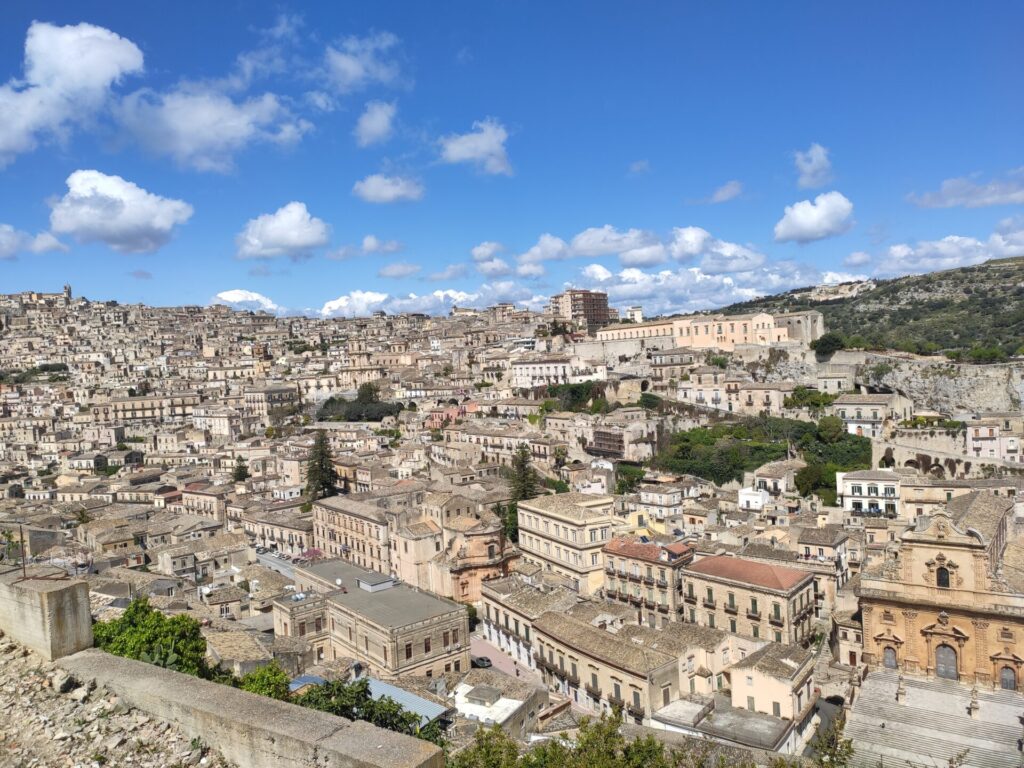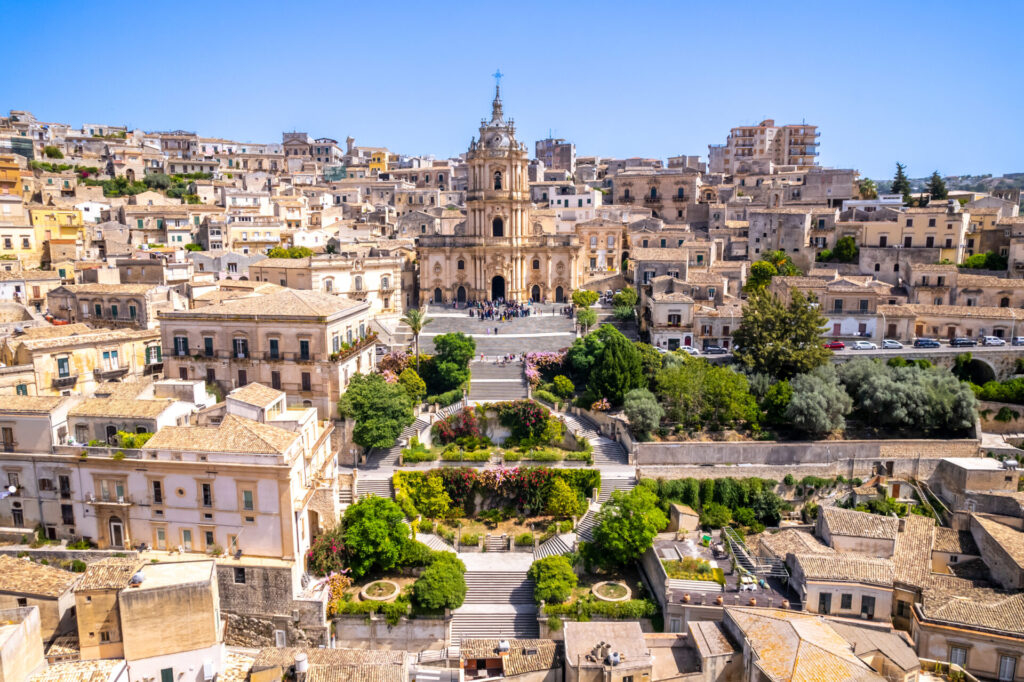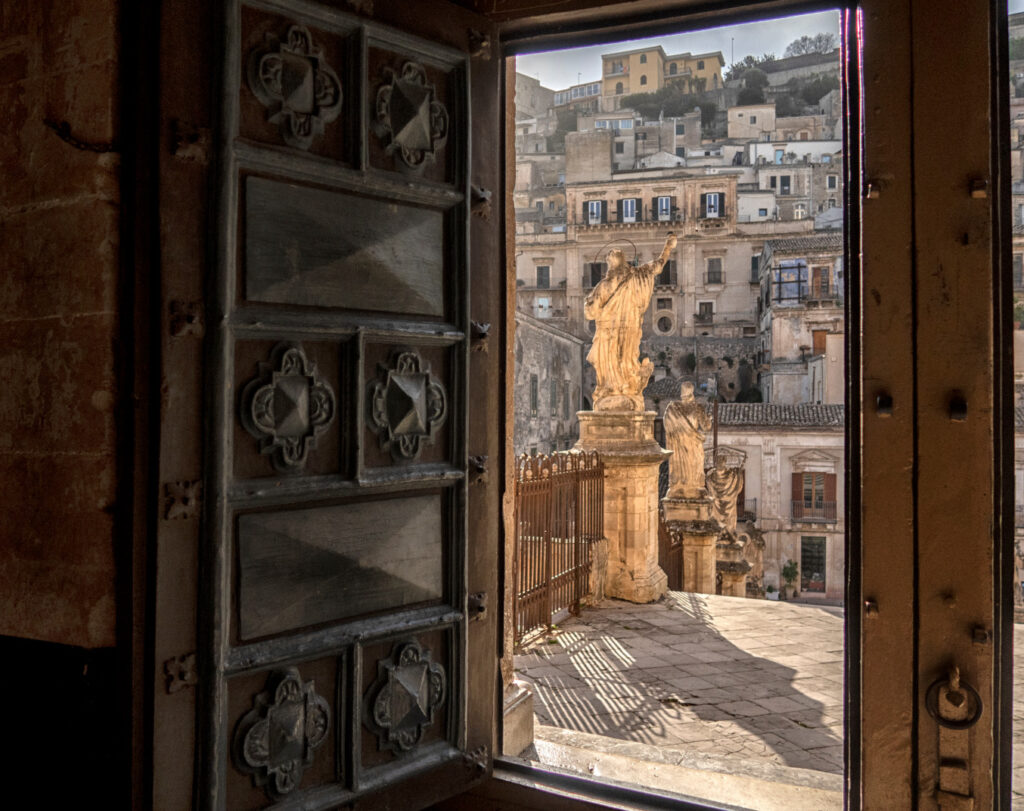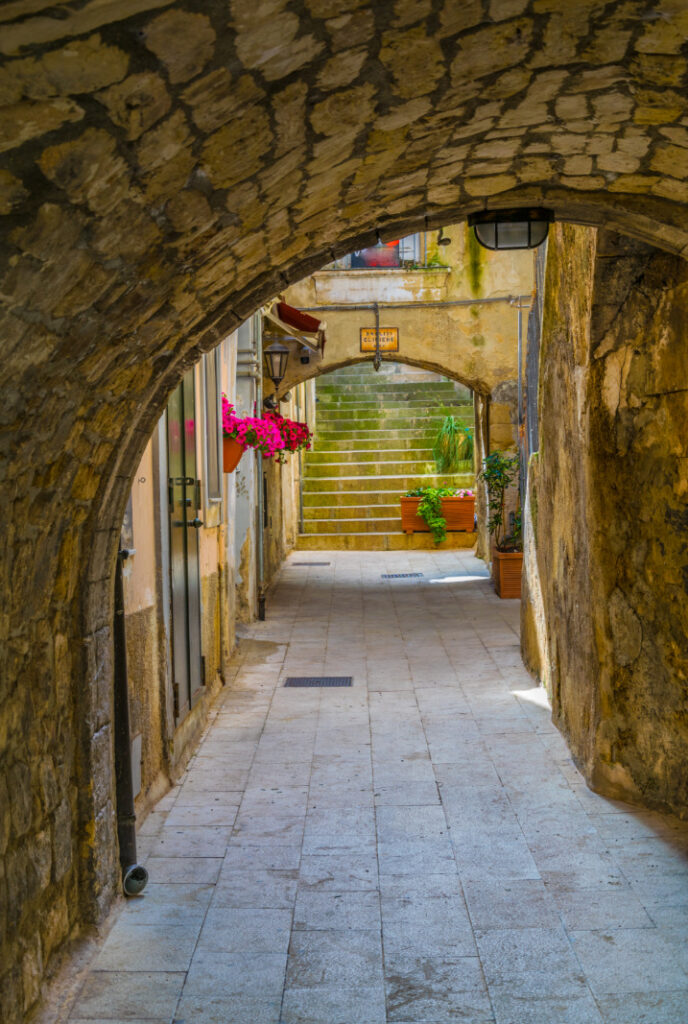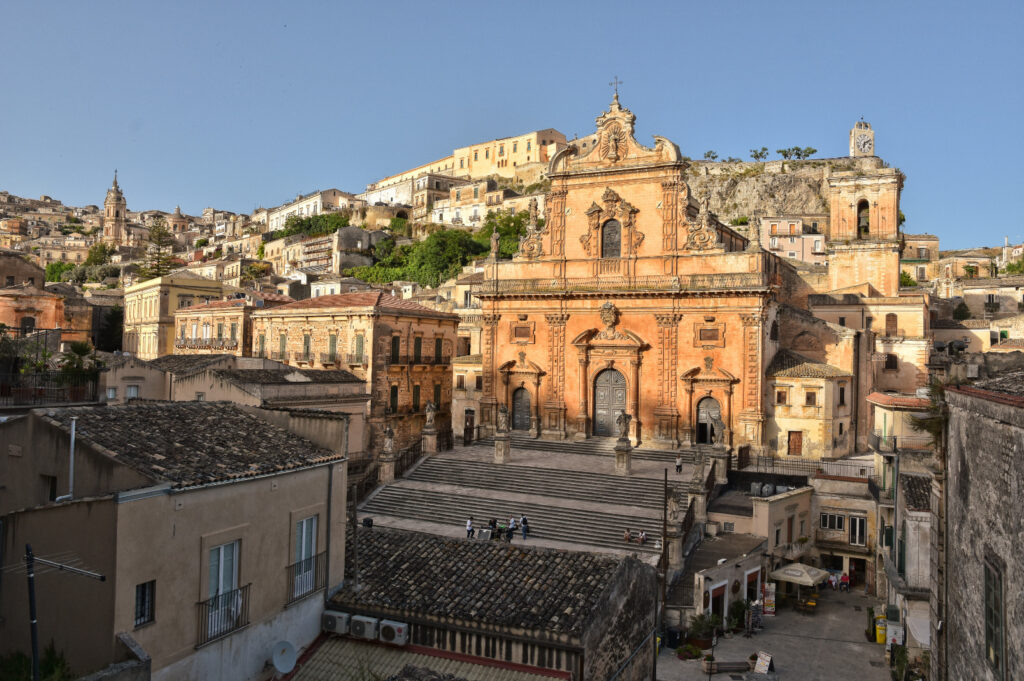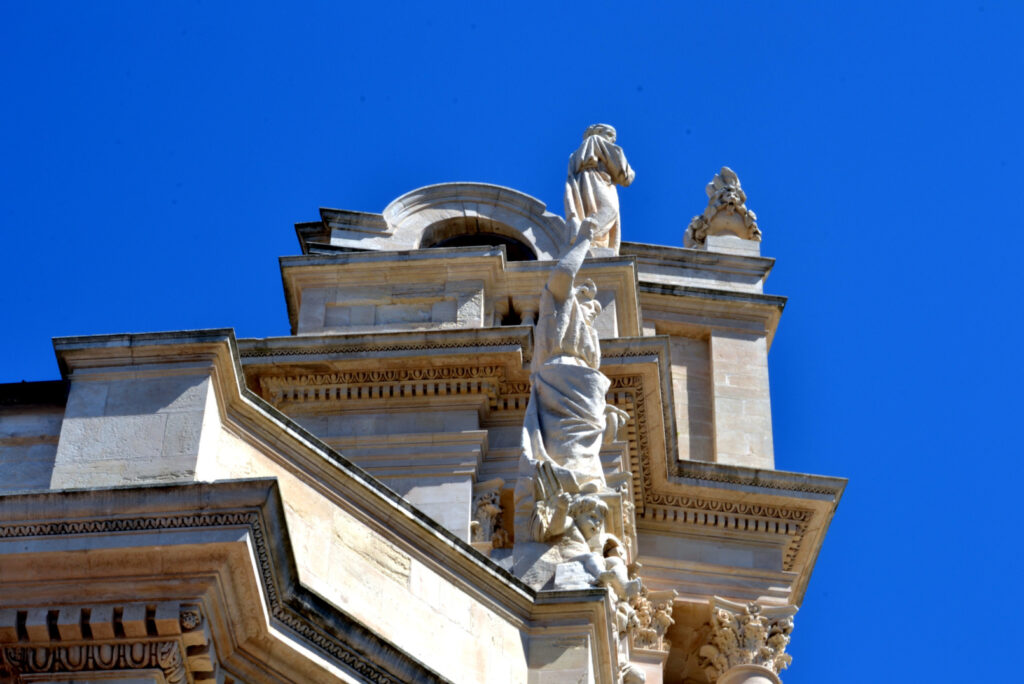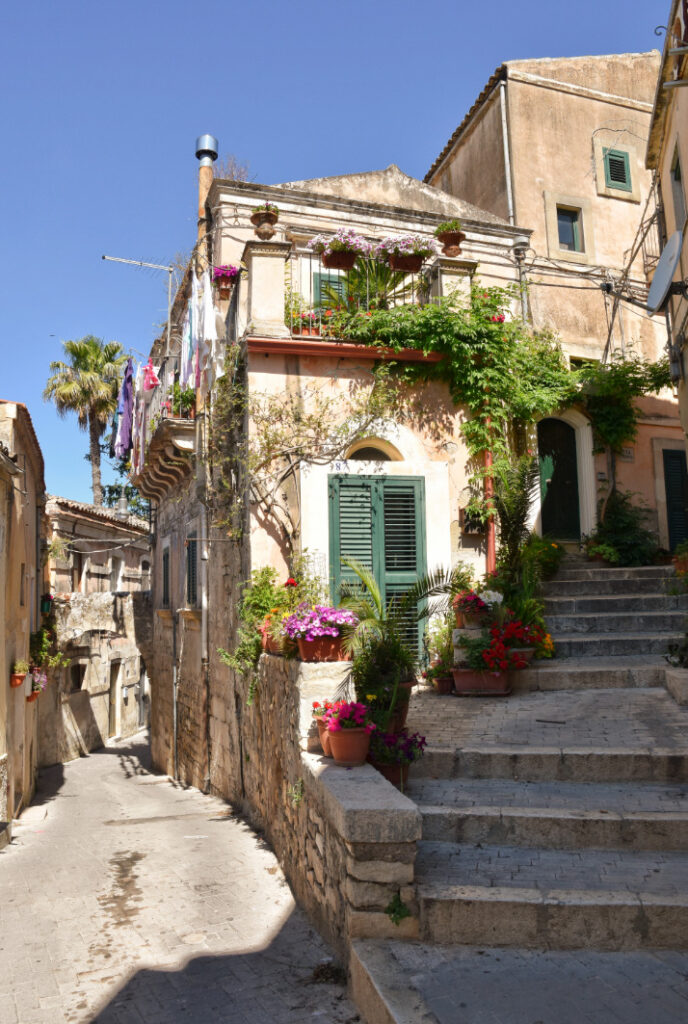Modica
Baroque, sweets and chocolate
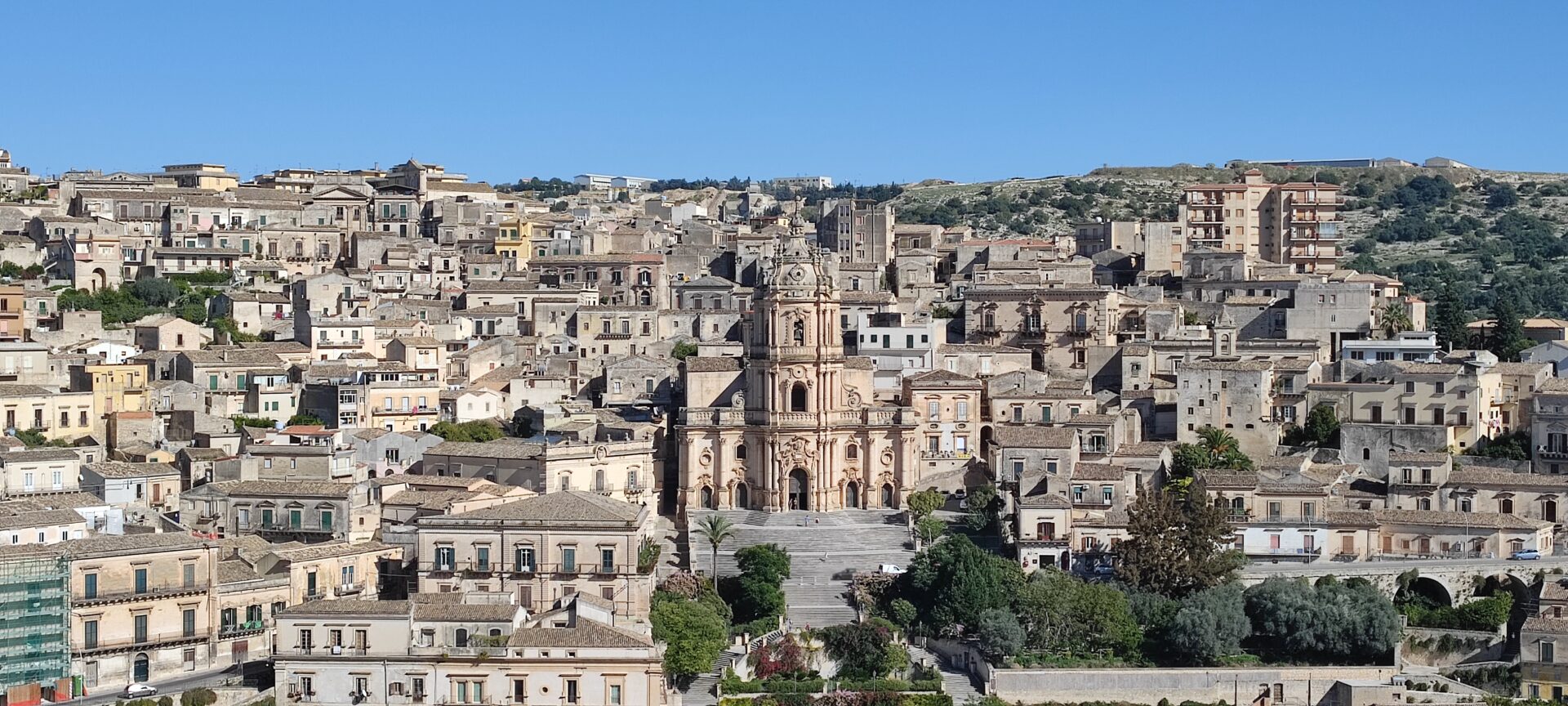
A sky-gazing Baroque spirit, elegant World Heritage monuments, its unmistakable light, traditional sweets and typical chocolate make Modica a must-see destination of the “Enjoy Barocco” Destination. The city owes its current appearance to the 1693 earthquake, subsequent reconstruction, and an important history that saw it as the capital of a powerful county until the early 1800s.
The city’s historic center is developed between Modica Alta and Modica Bassa. The oldest core of the city is the one perched on the hill, around the Castle of the Counts and the scenic Cathedral of St. George. The neighborhood above has the appearance of an eternal nativity scene, made up of quaint little houses climbing up the hill. Below, within narrow valleys, the city found new space for development after the earthquake that destroyed southeastern Sicily in 1693. Here the Cathedral of St. Peter the Apostle is undoubtedly the most important monument, and the statues of the twelve apostles on the steps stand monumental and imposing. Also at the bottom of the valley a short distance away, the Collegiate Church of Santa Maria di Betlem preserves the Palatine Chapel, one of the most important examples of late Sicilian Gothic architecture.
After the earthquake, the city regained its artistic and architectural momentum thanks to the great construction sites of the three imposing Collegiate churches of St. George, St. Peter the Apostle, and St. Mary of Bethlehem, which to this day give visitors a route that, together with the rock remains and museum exhibits, ranges through countless artistic styles, finding in the late Baroque the splendor and beauty of the area.
Moving away from the city center, one crosses a lush and bright countryside where by visiting the numerous “Canyons” such as Cava d’Ispica and Cava dei Servi, it is possible to admire the first rock settlements in the area, experience a unique relationship with nature, and rediscover the adventures and landscapes that Grand Tour travelers saw in the 18th century.
Marina di Modica is the city’s seaside hamlet with large beaches over which the Blue Flag flies. The sea, monuments, gastronomic excellence and cultural fervor make Modica an unmissable salon, an important and must-see travel destination.
This is where Montalbano, Italy’s most famous Inspector who conducted many of his adventurous investigations in the city, passed through in recent years.
What to see in Modica: the churches and monuments
Castello dei Conti di Modica

Emblematic witness to the ancient military fortress and residence of the Counts of Modica. The entire castle area was modified after the 1693 earthquake when it became the home of the city’s governor. From the courtyards and terraces there are stupendous views of the city and you can reach the Clock Tower, the icon of Modica.
Collegiata di San Giorgio

The cathedral in the upper town is the symbolic monument of Modica, one of the most important Baroque architectures in the Val di Noto. At the top of an elegant multi-flight staircase, the elevation soars high into the sky with sinuous progression. An illustrious Collegiate Church since the 17th century, inside it preserves many treasures, including an important 16th-century polyptych and a sundial.
Collegiata di San Pietro Apostolo

Developed from the 14th century, the Lower Town Cathedral encompasses the splendor and charm of the late Baroque after reconstruction. Outside, a wide staircase with large statues of the twelve apostles introduces the temple in which a triumph of colors and decorations refer to Baroque, Rococo, and Neoclassical culture. The Cappella Mazara exhibition area holds the Treasure of the Collegiate Church, in which the artistic heritage that has recently been restored and made usable is possible.
Collegiata di Santa Maria di Betlem

The Marian Collegiate Church tells of ancient medieval atmospheres combined with late Baroque. The Palatine Chapel is the jewel of the church, architecture that survived the tragic 1693 earthquake. Frate Benedetto Papale’s Monumental Nativity Scene in 1882 is the largest nativity scene in the Val di Noto. Inside you can visit the Aula del Capitolo exhibition area where you can admire Baroque stuccoes and 18th-century canvases recently made available to the public.
Chiesa di San Giovanni Evangelista

The highest point in the city is touched by the spire above the Church of St. John the Evangelist. The building lends elegance to the Modica Alta neighborhood and is its main church. The refined elevation built in the late 19th century combines late Baroque elements with neoclassical tendencies. Inside, the statuary group of Our Lady of Sorrows and the painting of Our Lady of the Militia are surprising.
Chiesa di Santa Maria del Gesù

Not well known among the wonders of the city Modica because it was a prison since 1866, but it is certainly one of the most important and fascinating, now one of the most visited sites and a space for theater, art, and contemporary music. Passing through the complex of St. Mary of Jesus, one can read the history of the city from the 15th century to the present day. The cloister, punctuated by columns all different, alone is worth the visit!
Chiesa di San Nicolò inferiore

It is probably the oldest surviving church in Modica. Entirely dug into the rock it holds a well-preserved ancient rock painting cycle. Tucked away in the alleys of lower Modica, it is definitely a jewel worth discovering.
Chiesa di San Giacomo Outside the Walls

Walking down the lane that begins in the historic center, the church of St. James stands as one of the last vestiges of medieval times. Built along the valley of the fiumara that goes toward scicli, immersed in Mediterranean scrub, it was the arrival point of the “Way of St. James” that the people of Modica traveled from the Collegiate Church of St. Mary of Bethlehem in the month of July.
Complesso Monumentale del Carmine

Along Corso Umberto, the main street in the lower part of the city, is Matteotti Square. This is overlooked by the large Carmine Convent, now an exhibition center, the Pietro Floridia Auditorium, and the Carmine Church. The church, built in medieval times, partially survived the 1693 earthquake and shows late Gothic remains in the main portal, beautiful rose window, and a Chapel with 15th-century frescoes. Sec. Also inside the “Cona del Gagini” a statuary group of the annunciation made by the great Sicilian master Antonello Gagini.
Complesso Monumentale di San Domenico

Now the seat of the City Hall, the Convent of St. Dominic was built, beginning in the 16th century. Sec, over the course of more than three centuries by the Dominican Fathers settled in the city. The Complex includes the Chiesa di San Domenico, which houses inside the “Altarpiece of the Madonna of the Rosary,” a sublime work by Antonino da Noto made in the 16th century of Renaissance workmanship. In the cloister of the former Convent, now a venue for cultural events, insists the Crypt of St. Dominic, which was discovered only in 1972 and is now open again to visitors
Basilica Santuario Madonna delle Grazie

Nestled along the Monserrato hill, the shrine, a true center of spirituality, preserves inside the painting of Our Lady of Grace venerated by the city in the month of May. The church was entrusted to the order of Mercedarian Fathers, who over the centuries enriched it with Baroque elements.
Chiesa di Santa Maria del Soccorso

Baroque in all its splendor. Built by Architect Rosario Gagliardi soon after the earthquake, the church was the seat of the Jesuit Order. The convex facade, the broken gable tell of a change of style in art and history that abandons old styles to create new ones that will give identity to an entire territory.
Chiesa di San Paolo Apostolo

Called “Little St. Peter’s,” the church insists in the Casale neighborhood one of the oldest neighborhoods in the city. On the outside, statues of Apostles Peter and Paul accompany visitors to the interior where the temple is divided into three naves and where there is a fine depiction of Our Lady of Sorrows. The carved capitals of the nave tell of skilled stonemasons who created masterpieces of art.
Belvedere dell’Idria

Located on Hydria Hill in the Oriente district, the belvedere is a unique vantage point where one can observe not only the city but especially St. George’s Cathedral in all its splendor
Belvedere Pizzo

Hidden among the narrow streets of the neighborhood of the same name that surrounds and embraces the Church of St. John the Evangelist in upper Modica, the belvedere allows you to view lower Modica from a unique perspective, and observe the Ianni Mauro River that has created over the centuries the morphology of the city
Museo Civico Belgiorno
 Formerly a Benedictine Sisters’ Monastery, today it is the city’s Civic Museum where archaeological artifacts and other works of art from the civic collection are kept. Among the most valuable pieces is the Heracles of Capheus, a bronze statuette dating back to the 3rd millennium BCE that depicts the hero after his first toil.
Formerly a Benedictine Sisters’ Monastery, today it is the city’s Civic Museum where archaeological artifacts and other works of art from the civic collection are kept. Among the most valuable pieces is the Heracles of Capheus, a bronze statuette dating back to the 3rd millennium BCE that depicts the hero after his first toil.Polo Museale Palazzo dei Mercedari

The former convent of the Mercedari Fathers is now home to a museum center that tells the story of the city and enhances the natural sciences. The Ethnographic Museum shows the ancient customs and traditions of the countryside, with reconstructions of domestic environments and ancient workshops. With Insecta, a journey into the world of insects, particularly the world of beetles, is realized. An exhibition tour with 2895 specimens from around the world. The MOF Ornithological Wildlife Museum houses an exhibition of rare and extinct Mediterranean species, a journey to discover what is lost and what we can save.
Salvatore Quasimodo Birthplace

Salvatore Quasimodo’s Birthplace Museum represents the place of memory par excellence; it is a place where one can succeed in grasping the essence of the story that is told there and the art that is manifested there through remembrance and reflection.
Teatro Garibaldi

Where there was a warehouse in the mid-19th century, an elegant theater with a Neoclassical elevation, three tiers of boxes and the gallery will be built. Even today it is still the center of the city’s cultural life despite a period of decline in which it will also become a cinema. After restoration in the late 1990s, it is again shown in its elegant beauty.
Museo della Medicina Tommaso Campailla

The original structure dates back to the 12th century when the Order of the Hospitallers of St. John settled in the city. The present complex was enlarged during the 17th century, taking the name Hospital of Piety where the Modican Medical School and medical philosopher Tommaso Campailla operated. It keeps inside the famous “Campailla Barrels” for the treatment of venereal diseases.
Museo del Cioccolato

A “sweet” visit to trace the history of chocolate from ancient times to the present day. Chocolate sculptures, an extraordinary collection of archival documents and a special miniature map of Italy with the most important Italian monuments made entirely of Modican chocolate can be admired.
Giardino esotico I Timpi

A natural terrace on the historic center, a green space dotted with dry stone walls and vegetation of the area. What makes it unique are the more than 40 species of bamboo, including five tropical ones, that came to Modica thanks to its creator, who gave the city a nature park within the city itself.
Museo Visuo Tattile

A museum that “can be touched” through which barriers can be broken down by allowing enjoyment of the city’s natural treasures even for those who experience a disability. The museum offers three-dimensional models with faithful reproductions of Hyblaean cultural heritage.
Mulino ad acqua – Museo in grotte

Located in the Archaeological Park of Cava Ispica, the museum consists of several rooms that tell the story of the rural civilization of the last century. In one room we visit the eighteenth-century water mill, of Arab type, which is still working and active in production.
Museo della Pipa

A place of skillful craftsmanship where fine woods curve, take on unusual shapes that are the result of thought, where precious materials are grafted to tell the story of an object that is present in man’s everyday life.
Museo della Memoria

The Museum of Memory traces through numerous artifacts, uniforms, helmets, military vehicles, unpublished documents and photographs the dramatic events that video Sicily in 1943 front during World War II.
Palazzo Castro-Polara-Grimaldi

Built at the foot of St. George’s Cathedral, the palace, which belonged to the noble Modican family, has remained unchanged over time. The still intact furnishings tell ancient stories, Art Nouveau atmospheres of the late 19th century when Modica was at the height of its post-Risorgimento history. An opportunity to discover the splendor, atmosphere and great people of the past who contributed to the city’s history.
The riches of Modica
Formerly known as Murikà, from the Sicilian “bare rock.” Famous for its Baroque churches and breathtaking views from the Clock Tower. The historic center is full of ancient buildings and churches, artisans’ workshops, bars and stores. It is exciting to get lost in its maze of narrow streets, stairways, courtyards and casuzze. Among its most representative monuments, St. Peter’s Cathedral and St. George’s Church, have been declared UNESCO World Heritage Sites.
Upcoming events
Find out about upcoming events in Modica: religious festivals, exhibitions, festivals, concerts, theater performances, food and wine events, and sporting events

